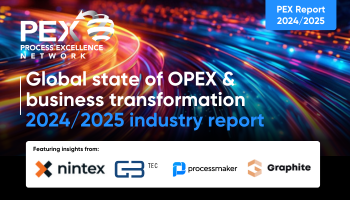Four ways to ensure digital adoption success
How to blend traditional change management techniques, employee feedback, strategically aligned metrics and digital adoption platforms to empower employees to embrace new technology
Add bookmark
Organizations are investing more than ever in digital transformation yet the failure rate, 70 according to McKinsey, remains stubbornly the same. One way organizations are starting to tackle this problem is by establishing digital adoption strategies to ensure employees are eager to embrace new technology and use it to its full potential.
Digital adoption is the process of empowering users to leverage digital technologies to their fullest capabilities, cultivating transformational, digital-first mindsets in non-technical employees and establishing a framework to measure the ROI of technology. The goal is not to simply teach employees how to use a new tool or technology, but implement new ways of working and empower users to proactively innovate.
We recently wrote a full in-depth, industry report on digital adoption that includes an overview of the topic, examples of real-world success stories and best practices for implementation. Below we have highlighted the four essential ingredients to digital adoption success based on the research that went into the report.
Don't miss any news, updates or insider tips from PEX Network by getting them delivered to your inbox. Sign up to our newsletter and join our community of experts.
Build desire for new technology pre-implementation
One of the most common mistakes organizations make, according to the experts we spoke to, is waiting until the last minute to introduce new technology. Instead, digital adoption leaders should start building desire for change long before the new technology or transformation takes place.
“As proponents of Prosci’s ADKAR model, a popular change management framework, our goal is to build desire for change,” Swiss Re Corporate Solutions’s VP – digital adoption lead, Ashley Yazbec, explains. “In order to do this, we include users in the technology development and change process.”
One new project her team is considering is the creation of a long-term roadmap of change, an easily accessible resource where users can find out what new projects are on the horizon, what changes they will bring about and how they all intersect to deliver business value. In addition to building awareness, Yazbec believes such an approach will help give users a voice in how these changes are made months, if not years, ahead of time.
Use employee feedback to measure and maximize success
To measure success of individual digital adoption projects, the digital adoption team at Swiss Re Corporate Solutions looks at classic technology adoption metrics such as process adherence, login rates (how many people log into the new system vs. the old) and support ticket volume.
Yazbec, however, cautions that “success should not just be measured by how many people adopt the tool”.
“You also need to look at the mindset of employees and how they have perceived their adoption experience,” Yazbec advises: “Employee surveys help prove that people are happier with the new technology tools and using them more, which in turn can help you illustrate how digital adoption increases ROI.”
Employee pulse surveys differ from traditional employee surveys in that they are shorter and are sent to employees on a regular basis (usually monthly or weekly). As the intervals between each survey are quite narrow, pulse surveys help organizations identify and resolve issues much faster than traditional methods. In addition, they help facilitate the creation of continuous feedback loops similar to those leveraged in Agile software development environments.
“The ultimate, future-state goal is to consumerize the employee user experience by applying the same product development methodologies to internal applications as we do to customer-facing ones,” Beverly Troxtell, former HR operations leader at PayPal, explains. “Leading-edge organizations are already starting to leverage continuous listening mechanisms, polling features and focus groups to gain deeper insight into the user experience.”
Leveraging this new wealth of internal user experience data, organizations can eventually start delivering internal software products that are just as easy to use as consumer-facing applications such as Uber, Spotify and Venmo.
Metrics combined with constant communication are essential to achieving strategic alignment
A recent EY report, The Digital Investment Index, found that 79 percent of executives from companies that have gained the highest returns on digital investments (defined as eight percent or more) have a formal program in place to help them identify, measure and report digital investment outcomes. Many digital adoption leaders we spoke to confirm that they are leveraging traditional IT metrics such as total cost of ownership (TCO) and support ticket volume to communicate the ROI of digital adoption strategies.
They caution, however, that these metrics only tell part of the story and may not be relevant to all leaders and stakeholders.
“Whatever metrics you are looking at, they must directly link back to business outcomes,” Guillermo Miranda, senior advisor to BetterUp and former chief learning officer at Boeing and IBM, advises. “Emphasize big-picture business outcomes that will resonate with the highest levels of the organization such as customer satisfaction, productivity per employee and safety scores.”
Leverage a digital adoption platform to gain full visibility into digital adoption
Organizations looking to track adoption across multiple applications, workflows and systems should consider investing in a comprehensive digital adoption platform (DAP). Vendor agnostic, DAPs can be layered on top of other software products, apps or websites to monitor and direct users across multiple systems and end-to-end processes. As users navigate their way through each product or process, the DAP will offer contextual information in real-time based on individual user behavior.
If a task that should take 10 seconds is taking a person 60 or 90 seconds, for example, the DAP will produce a pop-up recommending next steps and/or asking the user if they need more help. Considering professionals waste an average of 22 minutes per day dealing with IT issues, the productivity gains generated by providing guidance in real-time can add up fast. Thermo Fisher Scientific, for instance, experienced a 20% reduction in support tickets and a 2-3 hour daily productivity savings for its sellers after implementing its DAP
PEX Report 2024 global state of process excellence

PEX Network's annual report reveals the current state and future trends of process excellence. Based on a study profiling hundreds of global process excellence leaders, the report provides insights on how to leverage innovation, generative AI, and process intelligence to achieve operational excellence, customer-centricity, and organizational growth. Download your copy of the PEX Report 2024/2025 today and benchmark your process excellence journey against your peers.
Download Now



















